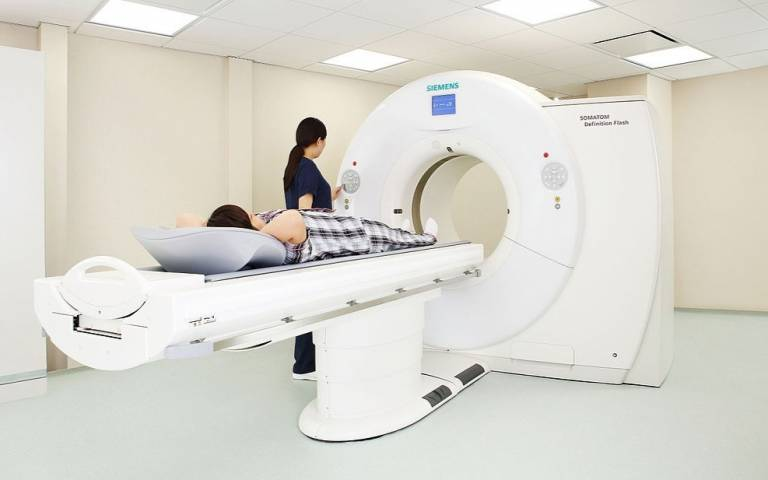Jul 24 2020
In a new study, researchers from University College London (UCL) report that a computerized tomography (CT) scan technique that breaks up a full X-ray beam into thin beamlets can offer the same image quality at a considerably reduced radiation dose.
 CT scanner. Image Credit: Wikimedia Commons.
CT scanner. Image Credit: Wikimedia Commons.
Demonstrated using a micro CT scanner and a small sample, the new technique could positively be adapted for medical scanners and employed to minimize the amount of radiation that millions of people are exposed every year.
A CT scan is a kind of X-ray that generates highly accurate cross-sectional views of the inner side of the body. It helps guide treatments and diagnose diseases such as cancers.
Past studies have suggested CT scans may cause a small increase in lifelong cancer risk because their high-energy wavelengths can damage DNA. Although cells repair this damage, sometimes these repairs are imperfect, leading to DNA mutations in later years.
As part of the new study, reported in Physical Review Applied, a mask with minuscule slits was placed over an X-ray beam, thus splitting the beam into multiple beamlets. Then, the to-be-imaged sample was moved in a cycloidal motion, thereby ensuring that the entire object was quickly illuminated—in other words, no parts of it were missed.
The new technique was then compared to traditional CT scanning techniques, in which the sample is rotated when a full X-Ray beam is directed on to it. The researchers found that it delivered the same image quality at a considerably reduced dose.
Being able to reduce the dose of a CT scan is a long-sought goal. Our technique opens new possibilities for medical research and we believe that it can be adjusted for use in medical scanners, helping to reduce a key source of radiation for people in many countries.
Dr Charlotte Hagen, Department of Medical Physics and Biomedical Engineering, University College London
Dr Hagen, a member of the UCL Advanced X-Ray Imaging Group, is the first author of the study.
Each year, nearly five million CT scans are performed in the NHS. The annual number of CT scans performed in the United States crosses 80 million. It is considered that CT scanning accounts for one-quarter of the total exposure of Americans to radiation.
In the case of traditional CT scans, an X-ray beam rotates around the patient. The new “cycloidal” method integrates this rotation with a concurrent forward and backward motion.
The use of beamlets allows a sharper image resolution. This is because the part of the scanner that “reads” the information from the X-ray can more accurately locate where the information comes from.
This new method fixes two problems. It can be used to reduce the dose, but if deployed at the same dose it can increase the resolution of the image. This means that the sharpness of the image can be easily adjusted using masks with different-sized apertures, allowing greater flexibility and freeing the resolution from the constraints of the scanner’s hardware.
Sandro Olivo, Professor, Department of Medical Physics and Biomedical Engineering, University College London
Olivo is the senior author of the study, which was financially supported by the Royal Academy of Engineering and UK Research and Innovation (UKRI).
Journal Reference:
Hagen, C. K., et al. (2020) Cycloidal Computed Tomography. Physical Review Applied. doi.org/10.1103/PhysRevApplied.14.014069.